| Estampa de pampa y cielo |
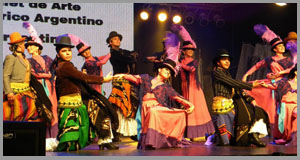 |
Nuestro Folklore, nuestra música tradicional nos brinda incontable posibilidades de manifestaciones, que de alguna manera nos identifica.
Es la figura del gaucho, dentro de este encuadre quizás quien pueda representar por si solo la imagen de nuestro acervo tradicional; que sin distinción de regionalizad, Pampeana, Cuyana o Norteña configuran muy bien por cierto la total representatividad de nuestra tradición.
Miguel Ángel Saravia nos transporta con esta puesta de autentica riqueza tradicional, verdaderamente.
They dance:
Cielito
Milonga
Chacarera sureña |
|
| Antología del Tango |
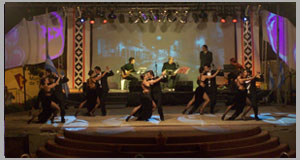 |
La presencia del Gaucho, en la Cultura Argentina es tan importante como indispensable, así como nuestra sociedad, en general sufrió transformaciones, el Gaucho también las tuvo.
En esta Estampa observamos como se va produciendo la transformación, pero sin perder la esencia, que es lo que nutre fundamentalmente su identidad, observaremos como a través de distintos ritmos musicales, perteneciente a la Región Bonaerense, como milongas y valses, vamos transportándonos al Salón, donde el Tango demuestra con galanteo y elegancia, su mas pura Estampa. |
|
| Himno Nacional Argentino (Argentine National Anthem) |
 |
The Argentine national anthem was created with a base of Opera Music, and represents various situations experienced in the course of the struggle for freedom. This time the BAFA interpret a creation that has to do with some musical rhythms of Argentina, as Footprint, Carnavalito, Chamamé, and Malambo.
In the end a mixture of Milonga and Chacarera give the brooch Representation of Culture and Art Musical Argentina.
They dance:
Himno Nacional Argentino
Milonchaca |
|
| Miguel de Güemes y la partida (Miguel de Güemes and the departure) |
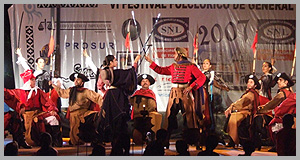 |
Tribute to Gral. Martín Miguel de Güemes
Miguel de Güemes declare to the whole population in assembly and adopted it as a type of military organization heading under which every 20 or 30 neighbors were a departure by an officer, who headed the military exercises, these exercises were mock war, raids on horseback, armed men spear gun or carbine, making threats and disorderly burden of the Cossacks, firing shots into the air as the Arabs, or put foot to land and forming groups of infantry, and scattered in shooters and quickly mounted on horseback longer with reconcentrándose suddenly alaridos wild as the Indians Pampas. .
They dance:
Malambo
Bailecito
Chacarera
Cueca |
|
| Duendes de la cueca (Cueca's goblins) |
 |
For a torcaza Zamba, for the Cueca a corzuela, stripping dust your zapatear Donoso, the two white handkerchiefs, as clouds musical, stirring in the valleys next to the green pasture.
They dance:
Cueca
Chacarera
Zamba
Escondido
Pericón by Mary |
|
| Mi Buenos Aires querido (My dear Buenos Aires) |
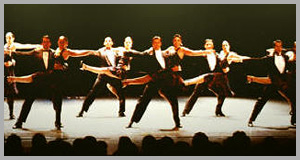 |
Gala Stamp of Argentinian Tango.
They dance:
El día que me quieras
Cuesta abajo
Volver
Por una cabeza
A fuego lento
Tanguera
Caminito
El choclo
La Cumparcita
Mi Buenos Aires Querido |
|
| Pampa Argentina (Argentine Pampa) |
 |
With the country party, all the Pampa is happy.
Al the incantation of the dance the tradition wakes up and the gaucho soul is magnanimity.
Typical costumes from the south.
They dance:
Malambo sureño
Prado
Refalosa
Chacarera |
|
| Carnaval Coya (Coya Carnival) |
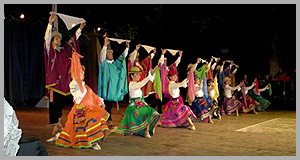 |
Old party and pagan celebration, it takes place in the argentine north west here starts, the flour faces, the ribbons, the per fun of the albahaca and the shout’s allegory of the hot wind, this is resumed in the performance; with vitality, with the enormous wealth of popular fervor to revive this Carnival Coya typical costumes of north west.
They dance:
Bailecito
Takirari
Carnavalito
Cueca Coya |
|
| Norte, violín y danza (North, violin and dance) |
 |
The violin in north dance, results a spontaneous vivacity and warmth, with the characteristic of this place. In a hard work Miguel A. Saravia has achieve a carefully y production, to point also its singularity, strength and the richness that the violin contribute to the interpretation of our popular music. Typical costumes of the North.
They dance:
Gato
Chacarera
Zamba
Cueca
Malambo de los Ponchos |
|
| Las milonguitas (The milongitas) |
 |
Tango was born as a dance. Spontaneous creation of the men and women as a different way of dance the known until then: habaneras, mazurcas, chotis, milongas. A popular product typical from outskirts, the stage where at the beginning was “The gaucho” transform into “compadre” and soon “compadrito”.
They dance:
El Choclo
La trampera
El Internado
Milonga de mis Amores
9 de Julio
Taquito Militar |
|
| Zamba del poncho (Poncho's zamba) |
 |
Our folklore, our traditional music provide us uncountable possibilities of examples that in one way or the other identify us. It’s the argentinian gaucho’s figure, inside of this framing maybe the one who car represent by himself the image of our cultural tradition; that without any regional Pampeano, Cuyano or Norteño form the total significance of our tradition. With the gaucho we can point to whom as a sign is related to: the Zamba. Miguel A. Saravia take us with this choreography to the traditional authentic richness really costumes typical of the North.
They dance:
Vals
Zamba
Gato
Escondido
Malambo Contrapunto |
|
| Acuarela de antaño (Age old watercolours) |
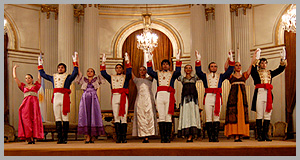 |
This a creation craned out with authentic imagination and take us in some way to an immortal time, where Gavota, Polca and Mazurca festoon the 1800 ball rooms and was danced by the old Buenos Aires’s society. Music dance, colour and harmony, express with historic fidelity shine this stamp that seems to come from the traditional painter’s palette. "There are partier at the poetics old rooms, dazzle the light’s room and brilliant, romantic it’s the charm’s night and fascination radiant candle turn on anywhere, old ancestry, distinguish hedmatrons, opulent patrician that like snuff heroic time’s view of the Patria, stamp of glorious past that has gone"... |
|
| A don José Francisco de San Martín (To Mr. José Francisco de San Martín) |
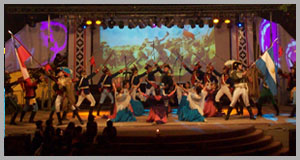 |
This national play (by O. Avellaneda) describes the men and his circumstance, to the light of an essential process from his evaluation emerge the concept “Argentinean archetype”, to be a classic model of the race is that we wish as an example, to the Argentinean community of the present and the future.This National Heroic Deed was performed by the BAFA of Miguel Angel Saravia in 1978. This ballet received that year two important awards: “Saint Clara de Asis” because of this play to pay tribute to Gral. San Martin and the “Silver Map” Given by Poet Association and Writers of Argentina in recognition of the artistic and cultural work by the BAFA. |
|
| Milagro, milagro (Miracle, miracle) |
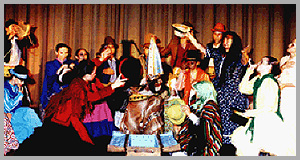 |
From the poet Miguel Tejada, with the music of Eduardo Casullo, Vocal 5 Group and the tale of the actor Luis Medina Castro, evoking the history of Lujan ‘s Virgin landlady of Buenos Aires, with the choreography of Miguel Angel Saravia.
The aim was narrate the history of our Landlady in a choreographic musical language according to the religious sense and simply to the public, all of this with the performance of the BAFA |
|
| Procesión a la Virgen del Valle (Procession to the valley's virgin) |
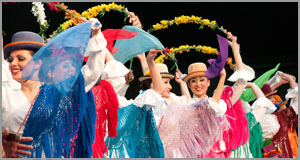 |
It’s important to emphasize the characteristic of an authentic celebration of the Argentinean northwest. It was originate in 1620 and says about a dale skinned virgin in a small city of Catamarca, it was called “the cave” in that place “the dark skinned of the valley” as it was known popularly, she begins her glorious action making many miracles to their denoted follower. Her consequent miraculous action it’s taken to considering popular and because of that this image dark skinned virgin of the valley it is in the high altar of the Cathedral and she is the landlady of Catamarca. Twice in the year it’s carried out the popular warn welcome from different places arrive devotees to show their gratitude. It’s typical of the Misachicos, that are small groups in procession that come closer with different banners. Musical instruments and offering they put this things around the virgin that has been taken to the center of the square and hoe is where the celebration begins and where Miguel Angel Saravia and his Ballet express this mystic fervor this Procession to the Valley’s Virgin. |
|
| El evangelio criollo (The creole gospel) |
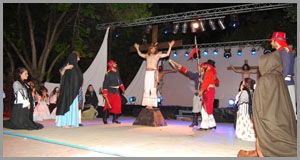 |
Many things has been celebrate because of the 2000 year but the only one that will sign exactly the Christianity’s anniversary it’s the indulgence of the evangelizing verb .
Argentinean has his own version of this great event through the music sing and dance of his folklore, the interpretation performed by BAFA of Miguel A. Saravia, who choreography this show giving it the colourful image and charge that mode “The Creole Gospel”, an unforgettable experience to any audience, with more than 20 prizes National and International from all over the world. |












